Exchange Lists for Meal Planning
How This Exchange List Works With Meal Planning
There are three main groups of foods in this exchange list. They are based on the three major nutrients: carbohydrates, protein (meat and meat substitutes), and fat. Each food list contains foods grouped together because they have similar nutrient content and serving sizes. Each serving of a food has about the same amount of carbohydrate, protein, fat, and calories as the other foods on the same list.
• Foods on the Starch list, Fruits list, Milk list, and Sweets, Desserts, and Other Carbohydrates list are similar because they contain 12 to 15 grams of carbohydrate per serving.
• Foods on the Fat list and Meat and Meat Substitutes list usually do not have carbohydrate (except for the plant-based meat substitutes such as beans and lentils).
• Foods on the Starchy Vegetables list (part of the Starch list and including foods (such as potatoes, corn, and peas) contain 15 grams of carbohydrate per serving.
• Foods on the Nonstarchy Vegetables list (such as green beans, tomatoes, and carrots) contain 5 grams of carbohydrate per serving.
• Some foods have so little carbohydrate and calories that they are considered “free,” if eaten in small amounts. You can find these foods on the Free Foods list.
• Foods that have different amounts of carbohydrates and calories are listed as Combination Foods (such as lasagna) or Fast Foods.
Foods are listed with their serving sizes, which are usually measured after cooking. When you begin, measuring the size of each serving will help you learn to “eyeball” correct serving sizes. The following chart shows the amount of nutrients in one serving from each list:
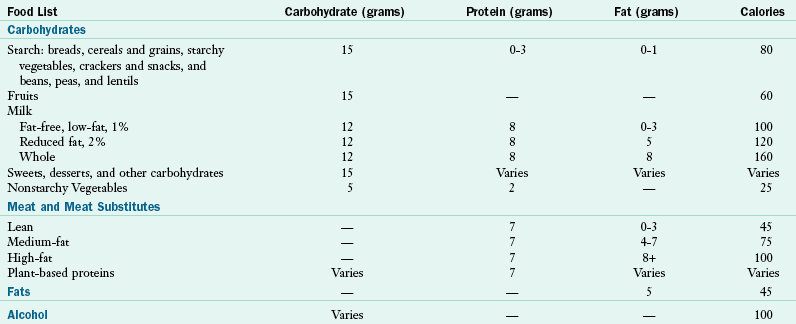
Starch
Cereals, grains, pasta, breads, crackers, snacks, starchy vegetables, and cooked beans, peas, and lentils are starches. In general, 1 starch is:
•  cup of cooked cereal, grain, or starchy vegetable
cup of cooked cereal, grain, or starchy vegetable
• 1 oz of a bread product, such as 1 slice of bread
•  oz to 1 oz of most snack foods (some snack foods may also have extra fat)
oz to 1 oz of most snack foods (some snack foods may also have extra fat)
Nutrition Tips
1. A choice on the Starch list has 15 grams of carbohydrate, 0-3 grams of protein, 0-1 grams of fat, and 80 calories.
2. For maximum health benefits, eat three or more servings of whole grains each day. A serving of whole grain is about  cup of cooked cereal or grain, 1 slice of whole-grain bread, or 1 cup of whole-grain cold breakfast cereal.
cup of cooked cereal or grain, 1 slice of whole-grain bread, or 1 cup of whole-grain cold breakfast cereal.
Selection Tips
1. Choose low-fat starches as often as you can.
2. Starchy vegetables, baked goods, and grains prepared with fat count as 1 starch and 1 fat.
3. For many starchy foods (bagels, muffins, dinner rolls, buns), a general rule of thumb is 1 oz equals 1 serving. Always check the size you eat. Because of their large size, some foods have a lot more carbohydrate (and calories) than you might think. For example, a large bagel may weigh 4 oz and equal 4 carbohydrate servings.
4. For specific information, read the Nutrition Facts panel on the food label.
Fruits
Fresh, frozen, canned, and dried fruits and fruit juices are on this list. In general, 1 fruit choice is:
Nutrition Tips
1. A choice on the Fruits list has 15 grants of carbohydrate, 0 grants of protein, 0 grants of fat, and 60 calories.
2. Fresh, frozen, and dried fruits are good sources of fiber. Fruit juices contain very little fiber. Choose fruits instead of juices whenever possible.
3. Citrus fruits, berries, and melons are good sources of vitamin C.
Selection Tips
1. Use a food scale to weigh fresh fruits. Practice builds portion skills.
2. The weight listed includes skin, core, seeds, and rind.
3. Read the Nutrition Facts on the food label. If 1 serving has more than 15 g of carbohydrate, you may need to adjust the size of the serving.
4. Portion sizes for canned fruits are for the fruit and a small amount of juice (1 to 2 tablespoons).
5. Food labels for fruits may contain the words no sugar added or unsweetened. This means that no sucrose (table sugar) has been added; it does not mean the food contains no sugar.
6. Fruit canned in extra light syrup has the same amount of carbohydrate per serving as the no sugar added or the juice pack. All canned fruits on the Fruits list are based on one of these three types of pack. Avoid fruit canned in heavy syrup.
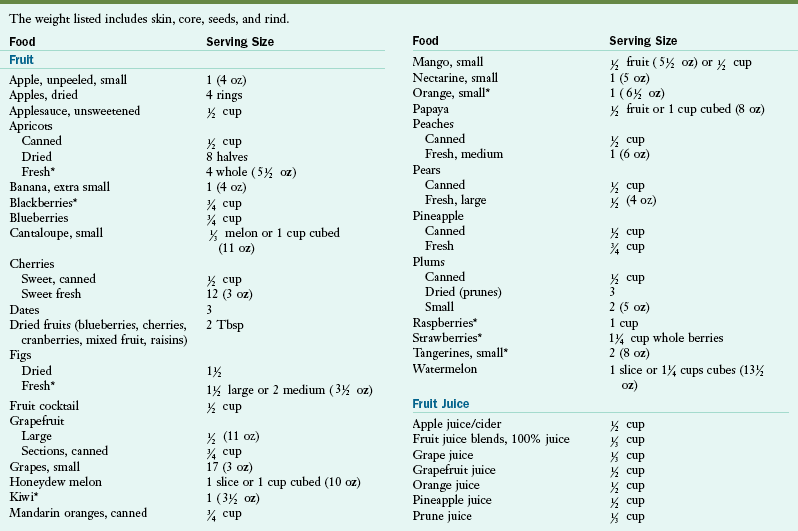
*More than 3 grams of dietary fiber per serving.
Milk
Different types of milk and milk products are on this list. However, 2 types of milk products are found in other lists:
Milks and yogurts are grouped in 3 categories (fat-free/low-fat, reduced-fat, or whole) based on the amount of fat they have. The following chart shows you what 1 milk choice contains:

Sweets, Desserts, and Other Carbohydrates
You can substitute food choices from this list for other carbohydrate-containing foods (such as those found on the Starch, Fruit, or Milk lists) in your meal plan, even though these foods have added sugars or fat.
Nutrition Tips
1. A carbohydrate choice has 15 grams of carbohydrate, variable grams of protein, variable grams of fat, and variable calories.
2. The foods on this list do not have as many vitamins, minerals, and fiber as the choices on the Starch, Fruits, or Milk lists. When choosing sweets, desserts, and other carbodrate foods, you should also eat foods from other food lists to balance out your meals.
3. Many of these foods don’t equal a single choice. Some will also count as one or more fat choices.
4. If you are trying to lose weight, choose foods from this list less often.
5. The serving sizes for these foods are small because of their fat content.
Selection Tips
1. Read the Nutrition facts on the food label to find the serving size and nutrient information.
2. Many sugar-free, fat-free, or reduced-fat products are made with ingredients that contain carbohydrate. These types of food usually have the same amount of carbohydrate as the regular foods they are replacing. Talk with your RD and find out how to fit these foods into your meal plan.
Nonstarchy Vegetables
Vegetable choices include vegetables in this Nonstarchy Vegetables list and the Starchy Vegetables list found within the Starch list. Vegetables with small amounts of carbohydrate and calories are on the Nonstarchy Vegetables list. Vegetables contain important nutrients. Try to eat at least 2 to 3 nonstarchy vegetable choices each day (as well as choices from the Starchy Vegetables list). In general, 1 nonstarchy vegetable choice is:
If you eat 3 cups or more of raw vegetables or  cups of cooked vegetables in a meal, count them as 1 carbohydrate choice.
cups of cooked vegetables in a meal, count them as 1 carbohydrate choice.
Nutrition Tips
1. A choice on this list ( cup cooked or 1 cup raw) equals 5 grams of carbohydrate, 2 grams of protein, 0 grams of fat, and 25 calories.
cup cooked or 1 cup raw) equals 5 grams of carbohydrate, 2 grams of protein, 0 grams of fat, and 25 calories.
2. Fresh and frozen vegetables have less added salt than canned vegetables. Drain and rinse canned vegetables to remove some salt.
3. Choose dark green and dark yellow vegetables each day. Spinach, broccoli, romaine, carrots, chilies, squash, and peppers are great choices.
4. Brussels sprouts, broccoli, cauliflower, greens, peppers, spinach, and tomatoes are good sources of vitamin C.
5. Eat vegetables from the cruciferous family several times each week. Cruciferous vegetables include bok choy, broccoli, brussels sprouts, cabbage, cauliflower, collards, kale, kohlrabi, radishes, rutabaga, turnip, and watercress.
Selection Tips
1. Canned vegetables and juices are also available without added salt.
2. A 1-cup portion of broccoli is a portion about the size of a regular light bulb.
3. Starchy vegetables such as corn, peas, winter squash, and potatoes that have more calories and carbohydrates are on the Starchy Vegetables section in the Starch list.
4. The tomato sauce referred to in this list is different from spaghetti/pasta sauce, which is on the Starchy Vegetables list.
Nonstarchy Vegetables
| Amaranth or Chinese spinach | Cucumber | Peppers (all varieties)* |
| Artichoke | Eggplant | Radishes |
| Artichoke hearts | Gourds (bitter, bottle, luffa, bitter melon) | Rutabaga |
| Asparagus | Green onions or scallions | Sauerkraut‡ |
| Baby corn | Greens (collard, kale, mustard, turnip) | Soybean sprouts |
| Bamboo shoots | Hearts of palm | Spinach |
| Beans (green, wax, Italian) | Jicama | Squash (summer, crookneck, zucchini) |
| Bean sprouts | Kohlrabi | Sugar pea snaps |
| Beets | Leeks | Swiss chard* |
| Borscht‡ | Mixed vegetables (without corn, peas, or pasta) | Tomato |
| Broccoli | Mung bean sprouts | Tomatoes, canned |
| Brussels sprouts* | Mushrooms, all kinds, fresh | Tomato sauce‡ |
| Cabbage (green, bok choy, Chinese) | Okra | Tomato/vegetable juice‡ |
| Carrots* | Onions | Turnips |
| Cauliflower | Oriental radish or daikon | Water chestnuts |
| Celery | Pea pods | Yard-long beans |
| Chayote* | ||
| Coleslaw, packaged, no dressing |
Meat and Meat Substitutes
Meat and meat substitutes are rich in protein. Foods from this list are divided into 4 groups based on the amount of fat they contain. These groups are lean meat, medium-fat meat, high-fat meat, and plant-based proteins. The following chart shows you what one choice includes:
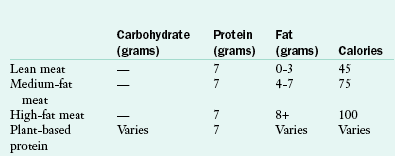
Nutrition Tips
1. Read labels to find foods low in fat and cholesterol. Try for 3 grams of fat or less per serving.
2. Read labels to find “hidden” carbohydrate. For example, hot dogs actually contain a lot of carbohydrate. Most hot dogs are also high in fat, but are often sold in lower-fat versions.
3. Whenever possible, choose lean meats.
4. Fish such as herring, mackerel, salmon, sardines, halibut, trout, and tuna are rich in omega-3 fats, which may help reduce risk for heart disease. Choose fish (not conimercially fried fish fillets) two or more times each week.
5. Bake, roast, broil, grill, poach, steam, or boil instead of frying.
Selection Tips
1. Trim off visible fat or skin.
2. Roast, broil, or grill meat on a rack so that the fat will drain off during; cooking.
3. Use a nonstick spray and a nonstick pan to brown or fry foods.
4. Some processed meats, seafood, and soy products contain carbohydrate. Read the food label to see if the amount of carbohydrate in the serving size you plan to eat is close to 13 grams. If so, count it as 1 carbohydrate choice and 1 or more meat choice.
5. Meat or fish that is breaded with cornmeal, flour, or dried bread crumbs contain carbohydrate. Count 3 Tbsp of one of these dry grains as 15 grams of carbohydrate.
The following foods are high in saturated fat, cholesterol, and calories and may raise blood cholesterol levels if eaten on a regular basis. Try to eat 3 or fewer servings from this group per week.
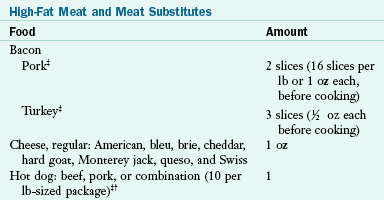
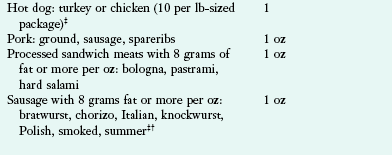
†Extra fat, or prepared with added fat. (Add an additional fat choice to this food.)
‡480 milligrams or more of sodium per serving.
Because carbohydrate content varies among; plant-based proteins, you should read the food label.
Fats
Fats are divided into 3 groups, based on the main type of fat they contain:
• Unsaturated fats (omega-3, monounsaturated, and poly-unsaturated) are primarily vegetable and are liquid at room temperature. These fats have good health benefits.
• Omega-3 fats are a type of polyunsaturated fat and can help lower triglyceride levels and the risk of heart disease.
• Monounsaturated fats also help lower cholesterol levels and may help raise HDL (good) cholesterol levels.
• Saturated fats have been linked with heart disease. They can raise LDL (bad) cholesterol levels and should be eaten in small amounts. Saturated fats are solid at room temperature.
• Trans fats are made in a process that changes vegetable oils into semi-solid fats. These fats can raise blood cholesterol levels and should be eaten in small amounts. Partially hydrogenated and hydrogenated fats are types of man-made trans fats and should be avoided. Trans fats are also found naturally occurring in some animal products such as meat, cheese, butter, and dairy products.
Nutrition Tips
1. A choice on the Fats list contains 5 grams of fat and 45 calories.
2. All fats are high in calories. Limit serving sizes for good nutrition and health.
3. Limit the amount of fried foods you eat.
4. Nuts and seeds are good sources of unsaturated fats if eaten in moderation. They have small amounts of fiber, protein, and magnesium.
Selection Tips
1. Read the Nutrition Facts on food labels for serving sizes. One fat choice is based on a serving size that has 5 grams of fat.
2. The food label also lists total fat grams, saturated fat, and trans fat grams per serving. When most of the calories come from saturated fat, the food is part of the Saturated Fats list.
3. When selecting fats, consider replacing saturated fats with monounsaturated fats and omega-3 fats. Talk with your RD about the best choices for you.
4. When selecting regular margarine, choose those that list liquid vegetable oil as the first ingredient. Soft or tub margarines have less saturated fat than stick margarines and are a healthier choice. Look for trans fat-free soft margarines.
5. When selecting reduced-fat or lower-fat margarines, look for liquid vegetable oil (trans fat-free). Water is usually the first ingredient.
Fats and oils have mixtures of unsaturated (polyunsaturated and monounsaturated) and saturated fats. Foods on the Fats list are grouped together based on the major type of fat they contain. In general, 1 fat choice equals:
Free Foods
A “free” food is any food or drink choice that has less than 20 calories and 5 grams or less of carbohydrate per serving.
Selection Tips
Combination Foods
Many of the foods you eat are mixed together in various combinations, such as casseroles. These “combination” foods do not fit into any one choice list. This is a list of choices for some typical combination foods. This list will help you fit these foods into your meal plan. Ask your RD for nutrient information about other combination foods you would like to eat, including your own recipes.
Fast Foods
The choices in the Fast Foods list are not specific fast food meals or items, but are estimates based on popular foods. You can get specific nutrition information for almost every fast food or restaurant chain. Ask the restaurant or check its website for nutrition information about your favorite fast foods.
Alcohol
Selection Tips
1. If you choose to drink alcohol, you should limit it to 1 drink or less per day for women, and 2 drinks or less per day for men.
2. To reduce your risk of low blood glucose (hypoglycemia), especially if you take insulin or a diabetes pill that increases insulin, always drink alcohol with food.
3. While alcohol, by itself, does not directly affect blood glucose, be aware of the carbohydrate (for example, in mixed drinks, beer, and wine) that may raise your blood glucose.
4. Check with your RD if you would like to fit alcohol into your meal plan.


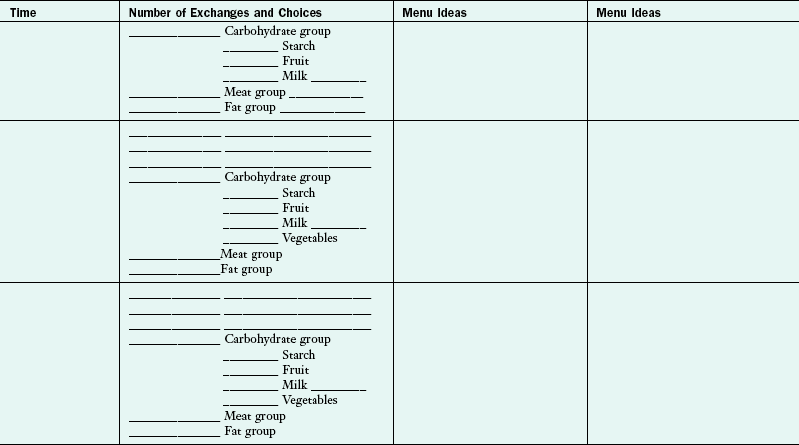
 cup of cooked rice or pasta
cup of cooked rice or pasta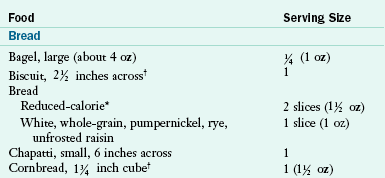
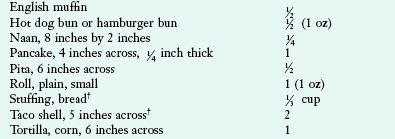
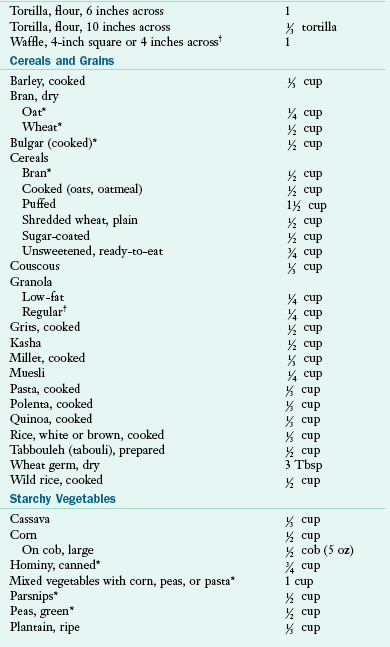
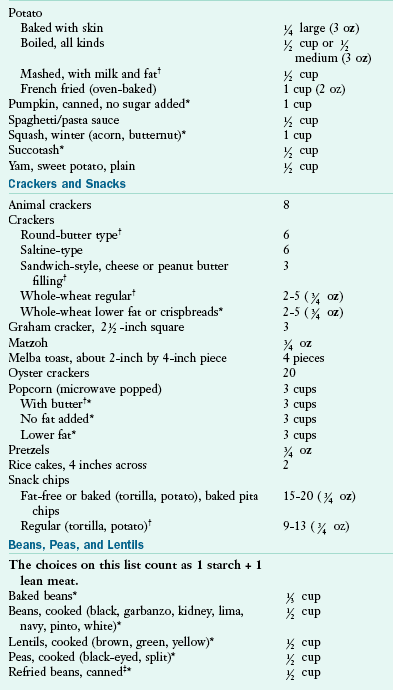
 cup of canned or fresh fruit or unsweetened fruit juice
cup of canned or fresh fruit or unsweetened fruit juice pint.
pint.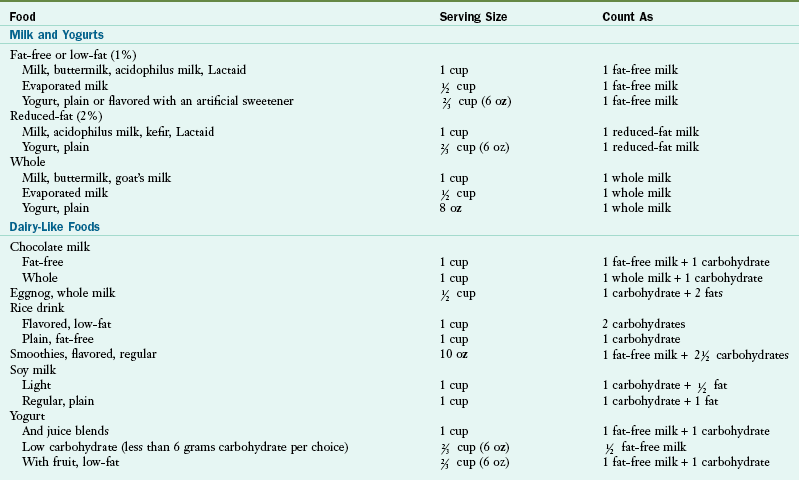
 cup
cup cup
cup pint
pint
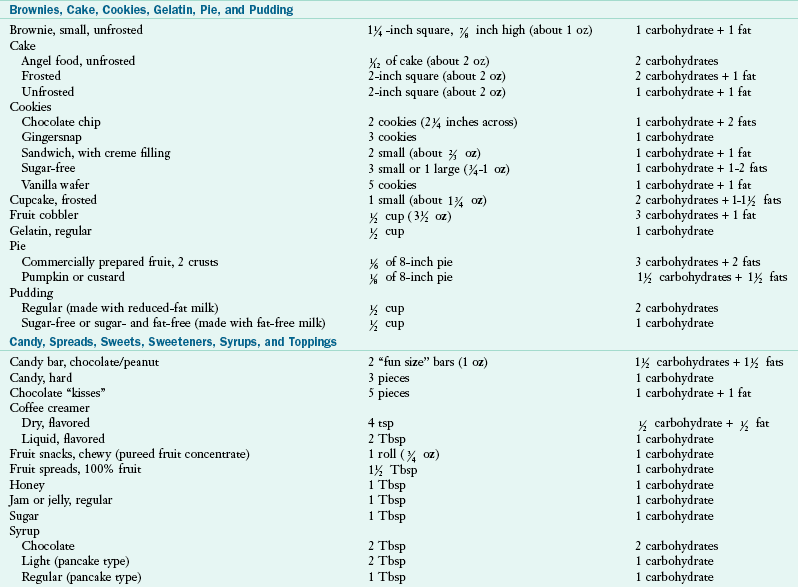
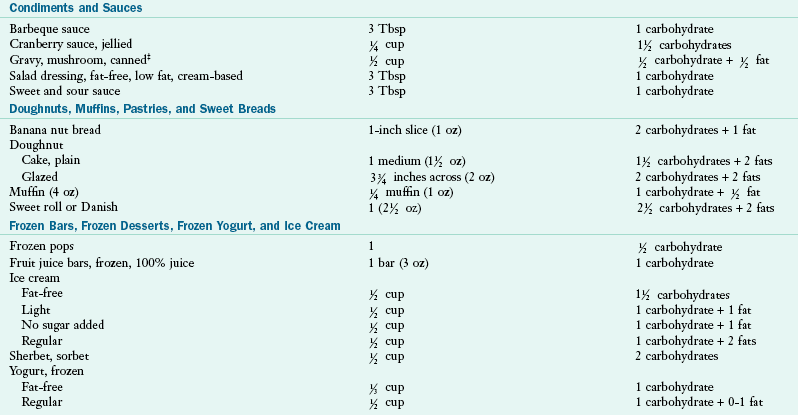

 cup of cooked vegetables or vegetable juice
cup of cooked vegetables or vegetable juice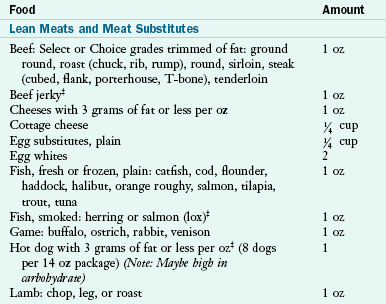
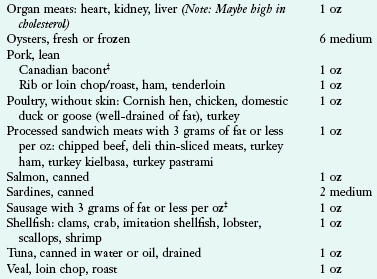
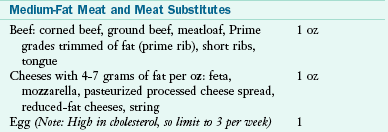
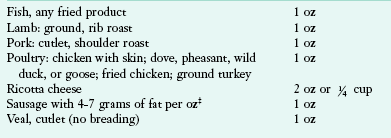
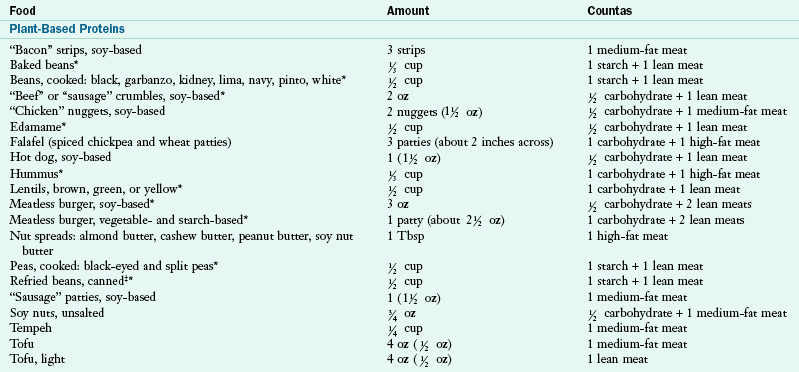


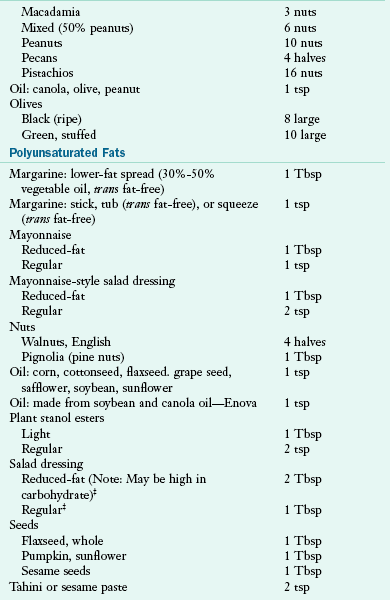
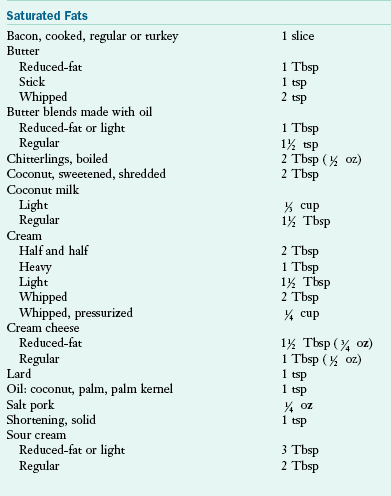
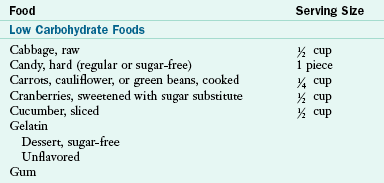
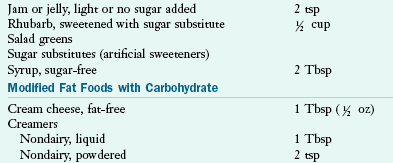
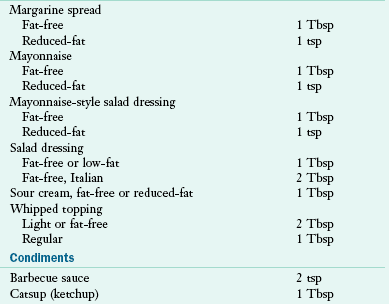
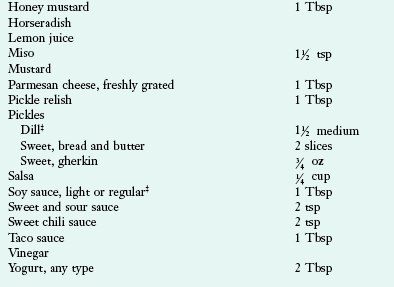
 cup blueberries
cup blueberries oz sliced cheese, fat-free
oz sliced cheese, fat-free oz lean meat
oz lean meat
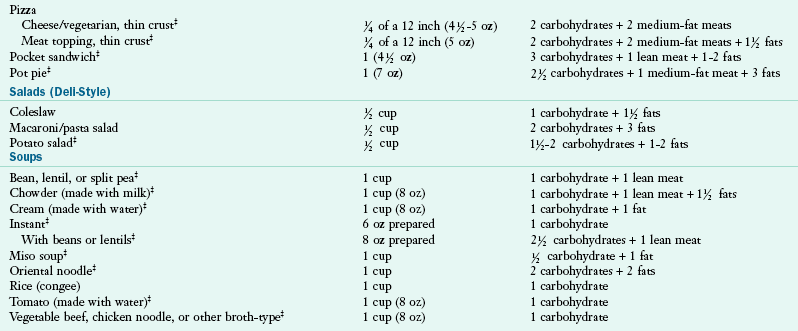
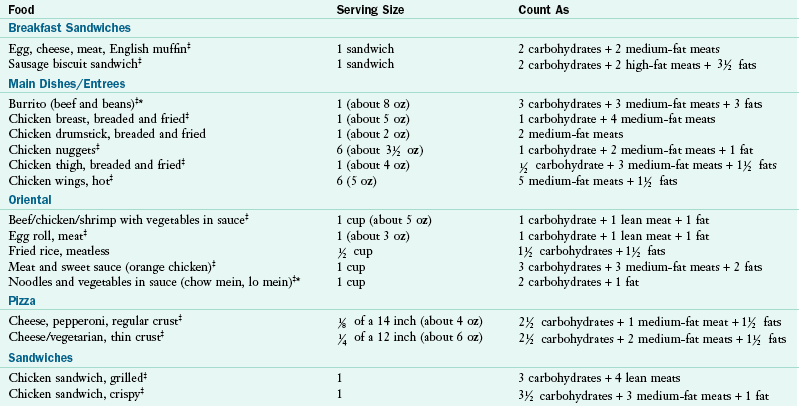
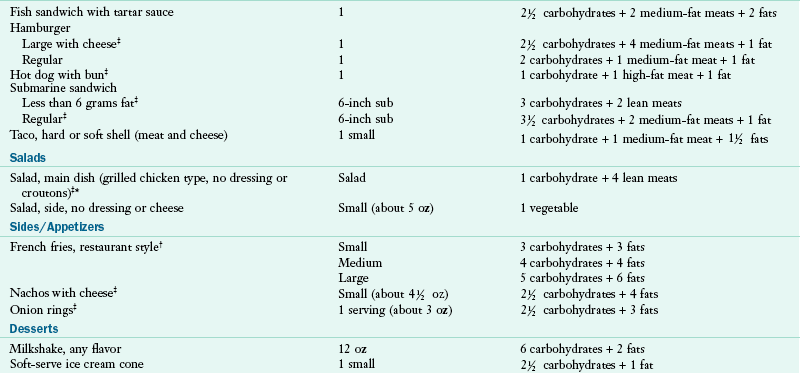
 oz absolute alcohol) has about 100 calories.
oz absolute alcohol) has about 100 calories.